Rubber fenders are very useful. They provide excellent protection to vessels. Have you ever noticed a ship colliding with a dock during docking? The rubber fenders absorb the impact of the collision. Without those, collisions would damage vessels.
Even during ship-to-ship docking, rubber fenders save both ships from big collisions. However, different types of rubber are used, and they all vary in performance. This guide will discuss the top 10 rubber fenders commonly used in docks. So, let’s get started!
Overview of Rubber Fenders
Rubber fenders act as a cushion to absorb kinetic energy. Ships are usually big in size and weight. When they berth, the boat collides with the docking structure. The fenders absorb the impact of this collision, saving the ship from potential damage.
Rubber fenders are among the most critical components of ship docking. Synthetic rubber is usually used to make them. It is flexible, strong, and durable. As I said, there are different types, each using a different kind of rubber.
They are made to compress when colliding with the dock. They absorb the shock or impact produced by the collision. The capacity of compression and absorption also varies from fender to fender.
Top 10 Rubber Fenders Commonly Used In Docks
All the rubber fenders absorb the shocks. However, their shock absorption capacity varies from one type to another. There are multiple varieties of fenders used by the ships. Here is the list of the top 10 rubber fenders:
- Cylindrical Rubber Fenders
- Cell Rubber Fenders
- Super Cone Rubber Fenders
- V-shaped (Arch) Fender
- D-Type Rubber Fenders
- DO Type Rubber Fenders
- Pneumatic Rubber Fenders
- Rotating or Roller Fenders
- Tug Boat Fenders
- W-Type Rubber Fenders
All these differ from each other in many ways. However, their primary functionality is the same: protecting the vessel. I will introduce these different rubber fenders in the section below.
1- Cylindrical Rubber Fenders
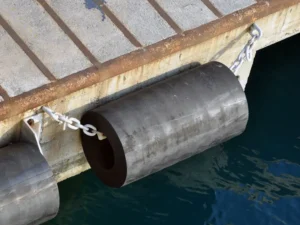
Cylindrical fenders are standard and one of the most used types. They are very affordable and offer optimal longevity. Their maintenance cost is also low. As the name suggests, they look like cylinders. Regarding installation, they require no hard work or specialized techniques for setup.
Cylindrical rubber fenders are usually suspended on the hull and hang around the ship. Their height can be altered or adjusted according to the ship’s requirements. They can be used with vessels of any size or shape. This is due to their versatility.
Let’s discuss their power and capacity. They are reasonably strong and can easily absorb small to mid-range impacts. These fenders are cheap. So, many ship owners customize them to fit their needs. Their cost-effectiveness and ease of usability are their key features.
2- Cell Rubber Fenders
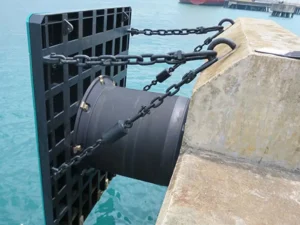
The rubber cell fenders have many hollow chambers. The chambers or cells connect across the ship’s length. The cells are compressible, so they absorb the impact during its compression. They are ideal for big vessel berthing as they absorb high impacts.
In some conditions, ships dock with relatively higher velocity. Even in the tidal variation, the ship’s speed can be slightly higher. In such situations, cell fenders come in handy. When ships collide with the dock, these cells absorb the impact force effectively. What makes these fenders popular is their low reaction force.
Due to their higher impact absorption capacity, they are also more expensive. People with smaller ships don’t prefer them due to the high cost. Their initial setup is also complex. However, professional ships that operate on a larger scale use these supercell fenders. Thanks to their higher energy absorption capability.
3- Super Cone Rubber Fenders
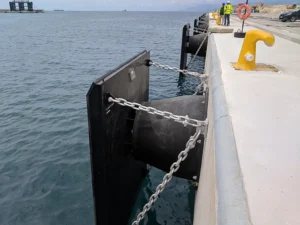
The cone rubber fenders have a conical shape. They have a rubber body and steel frame at the front. The steel frame makes these fenders solid and durable. Not only this but its rubber body and steel frame also improve deformation.
Experts say these fenders improve the deformation from 52% to 70%. This deformation does not add any additional reaction force. What makes these fenders prominent is their excellent impact absorption. Their shock absorption capacity is double that of the other types. Both small and large vessels use them, all thanks to their power and low reaction force.
4- V-shaped (Arch) Fender
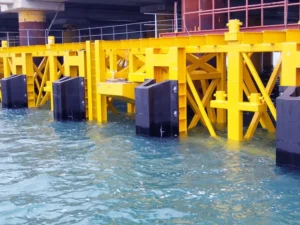
These V-type fenders are very simple by design. Their compact and user-friendly design facilitates easy installation. They have a V or arch shape. Their absorption of extreme impacts could be better. The simple design is the culprit behind lagging absorption capacity.
For low to mid-range impact, this fender works fine. Their performance goes down when the vessel approaches the dock at high speed. The reason is that they don’t adjust or accommodate different angles. You never know which part of the vessel will collide with the dock when it is at high speed.
These arch fenders are matchless in durability. They will easily stay with you for many years. Keep in mind that they also require regular maintenance. Better durability does not mean they are not prone to wear and tear. With proper maintenance, they will be with you for years to come.
5- D-Type Rubber Fenders
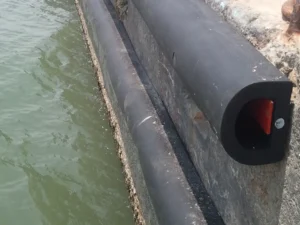
D-type fenders are getting more and more famous day by day. The reason is that they are affordable and durable. Due to lower costs, they are the go-to option for small boat owners. All these fenders are made with marine-grade flexible PVC.
This material is solid and durable. So, using it for fenders enhances strength, durability, and longevity. One disadvantage, however, is that they don’t have a high energy absorption capacity. Due to this, these rubber fenders are not recommended for use with bigger ships or vessels.
Like other types, D-type fenders are versatile and easy to install. Many modern D-type fenders come with pre-drilled mounting holes. Those holes enhance their ease of installation and usability.
6- DO Type Rubber Fenders
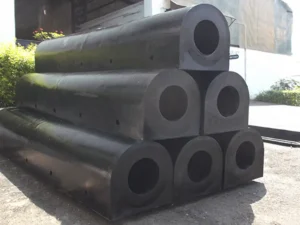
It is a subtype of D-type rubber fenders. However, it has better energy absorption capacity. As said above, the D-types are usually used in smaller boats and ships. But that is not the case with these DO-type fenders. Thanks to their high energy absorption.
Many ships use these to protect their ships’ stern and bow. Along with high energy absorption capabilities, they also don’t produce high reaction force. Its presence in the market gives ship owners the choice. Small boat owners use D-type, and big vessel owners use DO types.
Quick Information: Their shape and design are similar to D-types. As the name suggests, they are identical to the alphabet D, which has a D-shaped cross-section.
7- Pneumatic Rubber Fenders
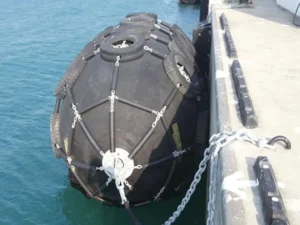
Pneumatic Rubber Fenders, also known as air fenders, are very common. They are usually used in ship-to-ship mooring. They consist of a hollow structure and rubber layers around it. High-pressure air is filled in the hollow structure, helping these fenders absorb shocks.
It is important to note that these fenders are very easy to use and install. They are inflated with air. If you want to relocate them, remove the air and relocate them. They are relatively simple and don’t need complex techniques.
Different sizes of pneumatic rubber fenders are available. Those include diameters ranging from 400 mm to 4000 mm and lengths ranging from 500 mm to 9,000 mm. However, many manufacturers also make custom-size rubber fenders. You can order the size that you need for your ship or boat.
8- Rotating or Roller Fenders

Rotation fenders are also known as roller fenders. They use a rotating rubber roller to control and absorb the impact. This roller is solid and works effectively to control the ship’s speed. As you know, a controlled speed or movement of a boat is necessary for safe docking.
This fender type is usually used in shipyards, docks, and ro-ro wharves. It also provides optimal energy absorption capacity. However, these fenders are rare. The reason is that they are costly. Not only this but their installation and disassembly are also complex. People still use them due to their low reaction force and high energy absorption.
9- Tug Boat Fenders
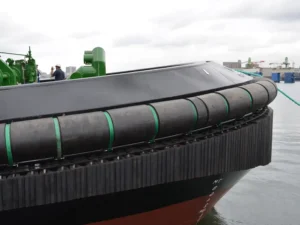
They are also known as corner fenders. Their usability is common when pushing and racking of tugboats is required. Generally, they are applied at the bow or stern. The good thing is that they don’t affect the ship’s maneuverability. The captain doesn’t get any disturbance in his views.
Their energy absorption is optimal. However, they are not designed for larger ships or vessels. The installation of these fenders is a bit tricky. The reason is that they are made to stick firmly to the sides of tugboats. So it keeps them from slipping off while towing other ships.
10- W-Type Rubber Fenders
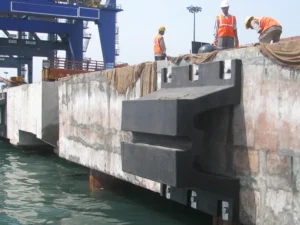
As the name suggests, these fenders have a W-shaped design. Some people also call them an M-shaped fender. They are well known for their excellent energy absorption and stability. Even when a big vessel collides with the dock, W-type fenders effectively absorb the impact.
Due to this stability, it can easily handle wharves above 10,000 tons. As the stress is evenly distributed on the fenders, they also quickly reduce the piling effect. W-shaped fenders work well for different docking situations. However, they’re great when you need extra protection for a boat’s front and back.
Things to Consider Before Choosing Rubber Fenders
Many manufacturers produce top-notch rubber fenders. But their selection depends on you. Choosing the wrong fender is like putting your investment at risk. There are a few factors that must be checked before making a decision. In the section below, we will explore those essential factors:
- Durability and Lifespan: Fenders are expensive. So compromising on the build quality will give you regret. Therefore, you should choose rubber fenders that are both durable and strong. If any company sells those at a low price, you should understand that the product will be low quality.
- Vessel Size & Impact Energy: How big is your boat or ship? Knowing and understanding the size will help you buy the suitable one. Bigger-sized fenders are expensive. If you have a smaller vessel or boat, choose the smaller-sized fenders. In this way, you can save some bucks.
- Maintenance Needs: Wear & tear in the rubber fenders is common. Proper maintenance and regular checks ensure the longevity of those fenders. Before buying a fender, check how pricey it would be to maintain it. I prefer the rubber fender with a lower maintenance cost.
- Installation Requirements: Different rubber fenders have different installation processes. Some of them are very complex. Their installation requires a lot of time. I don’t recommend buying those, even if they are cheap. The simple, quick, and easy installation of fenders is preferred.
- Supplier Reputation: Manufacturing rubber fenders requires time and expertise. Therefore, you should be patient and wise when deciding on a supplier. Expect quality from the suppliers instead of quick turnaround. We also provide different types of rubber fenders. You can trust us and get the work done quickly.
Frequently Asked Questions
What are rubber fenders?
Rubber fenders are like cushions. They absorb kinetic energy during ship berthing and docking. This prevents damage to both the vessel and the berthing structure.
What are the types of rubber fenders?
There are several rubber fenders, including Pneumatic, cylindrical, cone, cell, and arch fenders. Each type is designed for specific berthing conditions and vessel requirements.
How long do rubber fenders last?
The lifespan of rubber fenders varies depending on various factors. Generally, well-maintained rubber fenders can last for 12 to 15 years.
Can rubber fenders be recycled?
Yes, rubber fenders can be recycled. Once used utterly, they can be processed again. This makes them usable in various applications and products.
Can rubber fenders be customized for specific applications or vessel requirements?
Yes, rubber fenders can be customized with some effort. You can customize their size, shape, material composition, and mounting configurations. This customization can enhance performance and efficiency in various maritime applications.
Conclusion
Rubber fenders are super helpful. They protect vessels and docking platforms. However, different types are available, each offering distinct performance and features. Therefore, it is crucial to analyze them carefully.
Remember that your ship’s size also impacts decision-making. Smaller boats require smaller, inexpensive fenders, and vice versa. If you need a rubber fender of any type, contact us. We, as Fender manufacturers, have 15 years of experience. You’ll get your work done with 100% satisfaction guaranteed.
